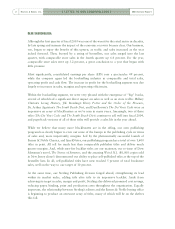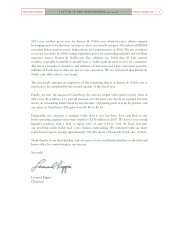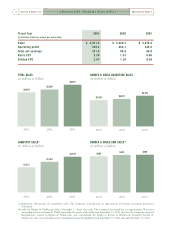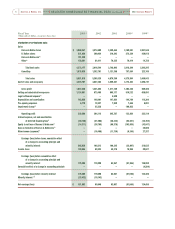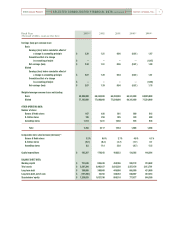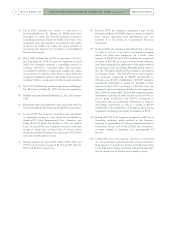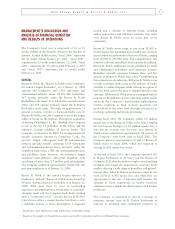Barnes and Noble 2003 Annual Report Download - page 10
Download and view the complete annual report
Please find page 10 of the 2003 Barnes and Noble annual report below. You can navigate through the pages in the report by either clicking on the pages listed below, or by using the keyword search tool below to find specific information within the annual report.
MANAGEMENT’S DISCUSSION AND
ANALYSIS OF FINANCIAL CONDITION
AND RESULTS OF OPERATIONS
The Company’s fiscal year is comprised of 52 or 53
weeks, ending on the Saturday closest to the last day of
January. As used in this section, “fiscal 2004” represents
the 52 weeks ending January 29, 2005, “fiscal 2003”
represents the 52 weeks ended January 31, 2004, “fiscal
2002” represents the 52 weeks ended February 1, 2003
and “fiscal 2001” represents the 52 weeks ended
February 2, 2002.
GENERAL
Barnes & Noble, Inc. (Barnes & Noble or the Company),
the nation’s largest bookseller1, as of January 31, 2004
operates 842 bookstores and 1,514 video-game and
entertainment-software stores. Of the 842 bookstores,
647 operate primarily under the Barnes & Noble
Booksellers trade name (31 of which were opened in fiscal
2003) and 195 operate primarily under the B. Dalton
Bookseller trade name. Through its approximate 73
percent economic interest in barnesandnoble.com llc
(Barnes & Noble.com), the Company is one of the largest
sellers of books on the Internet. Through its acquisition
of Sterling Publishing Co., Inc. (Sterling), the Company
is one of the top 25 publishers in the nation and the
industry’s leading publisher of how-to books. The
Company, as of January 31, 2004, has an approximate 64
percent economic interest in GameStop Corp., the
nation’s largest video-game and PC-entertainment
software specialty retailer2, operating 1,514 video-game
and entertainment-software stores primarily under the
GameStop trade name, a Web site (www.gamestop.com),
and publishes Game Informer, the industry’s largest
circulated multi-platform video-game magazine, with
circulation of more than 1.5 million paid subscriptions.
The Company employed approximately 56,000 full- and
part-time employees as of January 31, 2004.
Barnes & Noble is the nation’s largest operator of
bookstores1with 647 Barnes & Noble stores located in
49 states and the District of Columbia as of January 31,
2004. With more than 35 years of bookselling
experience, management has a strong sense of customers’
changing needs and the Company leads book retailing
with a “community store” concept. Barnes & Noble’s
typical store offers a comprehensive title base, a café,
a children’s section, a music department, a magazine
section and a calendar of ongoing events, including
author appearances and children’s activities, that make
each Barnes & Noble store an active part of its
community.
Barnes & Noble stores range in size from 10,000 to
60,000 square feet depending upon market size, and each
store features an authoritative selection of books, ranging
from 60,000 to 200,000 titles. The comprehensive title
selection is diverse and reflects local interests. In addition,
Barnes & Noble emphasizes books published by small
and independent publishers and university presses.
Bestsellers typically represent between three and five
percent of Barnes & Noble store sales. Complementing
this extensive on-site selection, all Barnes & Noble stores
provide customers with access to the millions of books
available to online shoppers while offering an option to
have the book sent to the store or shipped directly to the
customer. All Barnes & Noble stores are equipped with its
proprietary BookMaster in-store operating system, which
enhances the Company’s merchandise-replenishment
system, resulting in high in-stock positions and
productivity at the store level through efficiencies in
receiving, cashiering and returns processing.
During fiscal 2003, the Company added 0.6 million
square feet to the Barnes & Noble store base, bringing
the total square footage to 15.8 million square feet, a
four percent increase over the prior year. Barnes &
Noble stores contributed approximately 88 percent of
the Company’s total book sales in fiscal 2003. The
Company plans to open between 30 and 35 Barnes &
Noble stores in fiscal 2004, which are expected to
average 26,000 square feet in size.
At the end of fiscal 2003, the Company operated 195
B. Dalton bookstores in 44 states and the District of
Columbia. B. Dalton bookstores employ merchandising
strategies that target the mainstream consumer book
market, offering a wide range of bestsellers and general-
interest titles. Most B. Dalton bookstores range in size
from 2,000 to 6,000 square feet, and while they are
appropriate to the size of adjacent mall tenants, the
opening of book superstores in nearby locations
continues to have a significant adverse impact on B. Dalton
bookstores.
The Company is continuing to execute a strategy to
maximize returns from its B. Dalton bookstores in
response to declining sales attributable primarily to
1Based upon sales reported in trade publications and public filings.
2Based on the number of United States stores operated by GameStop and its total United States revenues.
9
2003 Annual Report ■Barnes & Noble, Inc.



